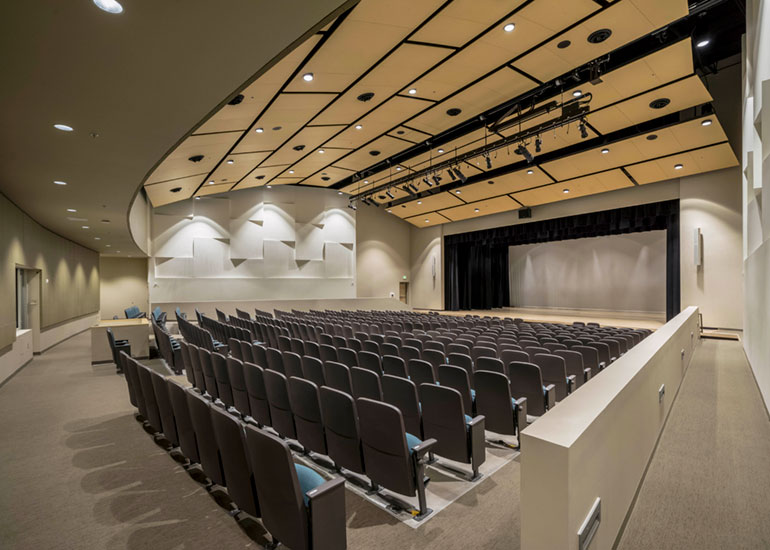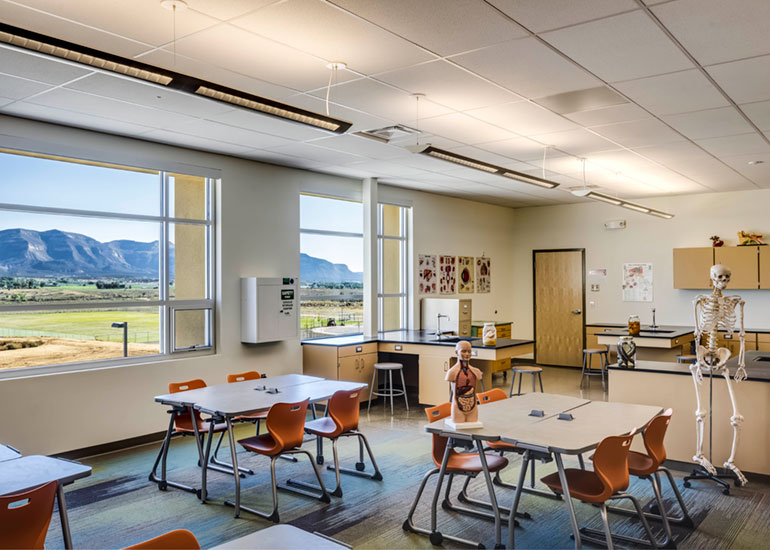Paying It Forward
Montezuma-Cortez Replacement High School
When it became cost prohibitive to refurbish the existing Montezuma-Cortez high school, the town received state funding and passed a bond to build a brand new energy-efficient, replacement high school. Designing sustainable, high-performing mechanical, electrical, plumbing and energy systems meant that the new school saves more energy than 79 percent of similar schools across the US.
Services:
- BIM
- Controls
- Electrical
- Mechanical
- Plumbing
- Sustainability
- Technology
Client
Montezuma-Cortez School District RE-1
Location
Cortez, CO
Industries
K-12 Education
Size
159,300 Square Feet
Timeline
30 Months
Cost
$41.4 Million
Sustainability
LEED Gold
Energy Star
Geothermal
Project Overview
Replacing the high school
The original Montezuma-Cortez high school built in 1967 posed serious health and safety issues. The District consulted with engineers and architects and estimated that it would cost at least 75 percent of the replacement cost to bring the existing school up to a minimally adequate standard. The District applied for and received a Building Excellent Schools Today (BEST) grant in 2012 from the Colorado Department of Education to fund 52 percent of a replacement high school. As part of the grant, and to pay for the remaining 48 percent of the new school, voters were asked to authorize a capital construction bond, which they approved in November 2012.
The Challenge
Environmentally conscious design
Design a 160,000 square foot new high school on an undeveloped 30-acre parcel that addresses community involvement, provides a quality project that is flexible, safe and secure, easy to maintain and operate, energy efficient and architecturally pleasing.
Sustainability
Sustainable mechanical, electrical and plumbing systems include:
Geothermal / ground source heat pump
High efficiency lighting & controls
Photovoltaics
Design & Implementation
Finding creative solutions
With high sustainability goals for the project, we utilized our in-house Certified GeoExchange Designer who was responsible for the design of the energy-efficient, geothermal heat pump system. A geothermal heat pump, also called a ground source heat pump is a central heating and/or cooling system that transfers heat to or from the ground. It uses the earth as a heat source in winter and as a heat sink in summer. This is a highly sustainable source of heating and cooling.
Our engineers worked collaboratively with the design team to integrate additional energy efficient measures. The team developed elongated classroom wings east-west, to minimize the western facade of the building, where glare and heat gain would be difficult to mitigate. The team worked together to maximize views of Sleeping Ute Mountain, Mesa Verde and the La Plata Mountains and natural light while balancing energy efficiency. This balance was achieved through studies of window sizes. South and west facing windows were recessed or shaded to reduce solar energy gain. Additional daylight was brought into spaces through the use of solar tubes. The team was able to provide quality daylight to over 82 percent of the classrooms and core learning areas and views to over 90 percent of the regularly occupied spaces.
Additional sustainability goals for the project included reducing energy consumption and cost by 40 percent as compared to a minimally compliant ASHRAE 90.1-2007 building and to design to an Energy Star rating of 75 or higher. Our engineers worked with the team to select building materials to produce a high-efficiency envelope including high-efficiency glazing and a reflective roof. Sustainable design features included: insulation, masonry, ground source heat pump system, packaged rooftop units, LED lighting.
The Outcome
Inspiring young minds to create
Because the new MCHS project was partially funded by the Colorado Department of Education’s BEST grant program, the design team was required to pursue Energy Star certification through the Environmental Protection Agency. The goal was to perform better than 75 percent of schools across the country. Energy Star’s preliminary reports from the first full year of operational tracking show that MCHS is saving more energy than 89 percent of similar schools across the country.
The high school uses about 30 kBtu (30,000 British thermal units) per square foot per year. By comparison, the average school in the country uses approximately 80 kBtu per square foot per year. MCHS used about 4.56 million kBTUs of electricity during the year. About 85 percent of that was generated from the city’s electrical grid. Nine percent was generated from natural gas, and five percent was from solar panels on the roof of the school. Solar panels on the roof of the school generated $7,811 worth of electricity during that year. Utilities at the school cost about 86 cents per square foot. Electrical HVAC accounted for 49 percent of the school’s usage, while electric plug loads accounted for 33 percent, lighting was 17 percent and gas heating was one percent.
The Results
- Better energy performance than 89% of similar schools across the country
- LEED Gold Certification
- Improved indoor air quality


Sometimes we see buildings are designed to be efficient but in practice they don’t live up to expectations. It’s great to see a school with (an Energy Star) score of 89. It shows the people operating the school know what they’re doing and they’re doing a great job.
Lauren Hodges, Energy Star Communications Representative
Project Partners
- Nunn Construction
- Dekker Perich Sabatini
-
Related Featured Project:
-
Rio Rancho Public Schools, V. Sue Cleveland High School
-
« Back to all Projects
